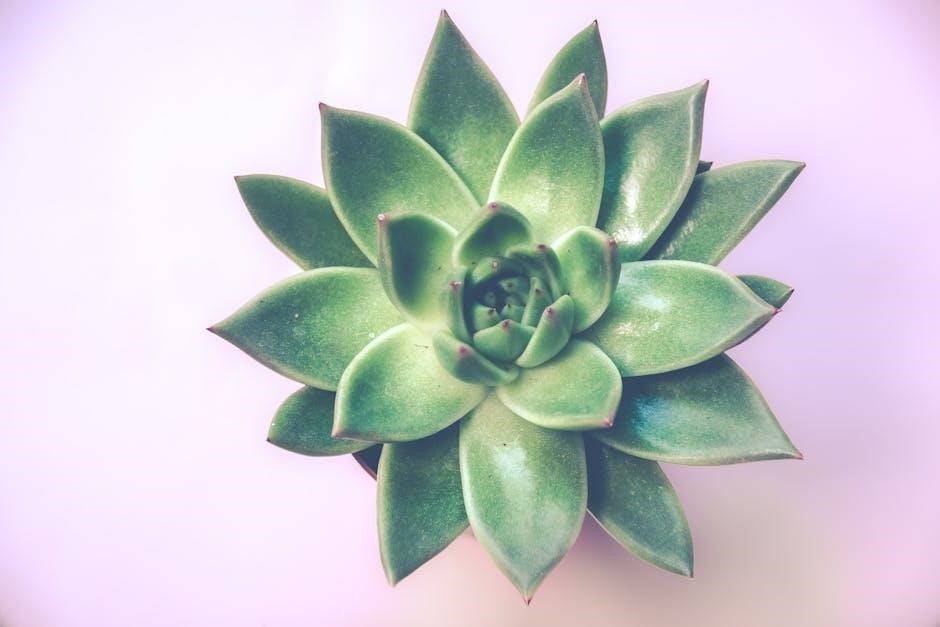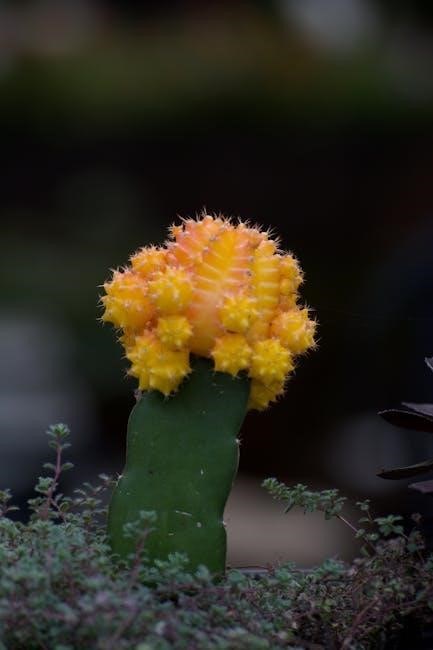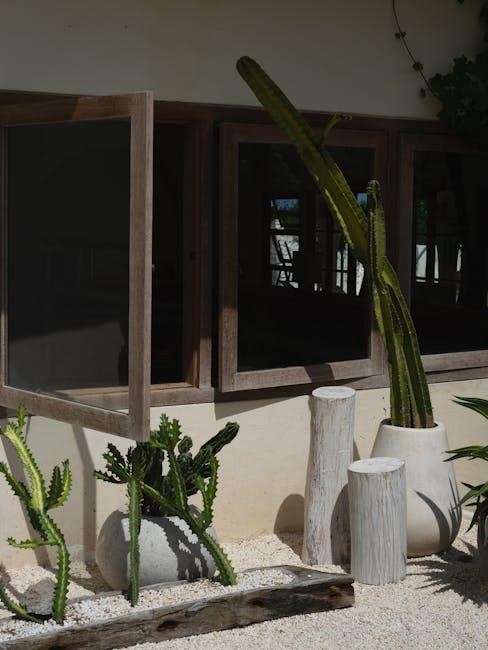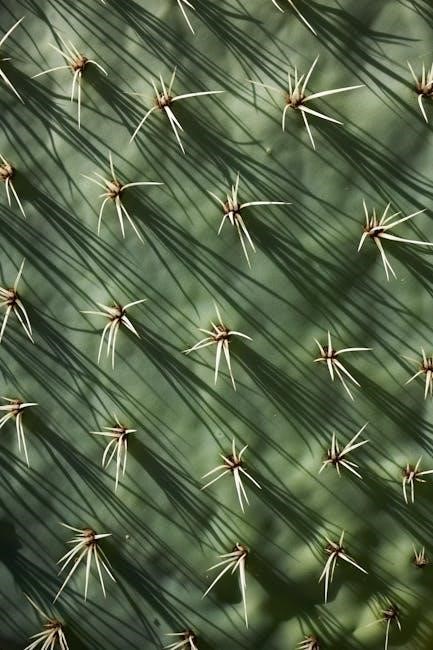cactus guide

Cacti are perfect low-maintenance houseplants, adding a touch of desert charm to any space. Their hardiness and unique beauty make them ideal for indoor environments, requiring minimal care.
1.1 Why Cacti Are Popular Indoor Plants
Cacti are highly sought-after indoor plants due to their low-maintenance requirements and unique, sculptural appeal. Their ability to thrive in neglect makes them perfect for busy individuals or those new to plant care. With their striking shapes and sizes, cacti add a touch of desert charm to any room. Additionally, they symbolize resilience and protection, making them meaningful additions to home decor. Their adaptability to indoor conditions and minimal watering needs further enhance their popularity, offering a hassle-free way to bring nature indoors.

1.2 Unique Features of Cacti
Cacti are distinguished by their unique areoles, small cushion-like structures from which spines, flowers, and branches grow. Their thick, waxy stems store water, enabling survival in arid environments. Spines not only protect against predators but also reduce water loss by shading the plant. Unlike most plants, cacti thrive in poor soil and require minimal watering. Their striking shapes, ranging from spherical to columnar, add architectural interest to spaces. These adaptations make cacti ideal for indoor cultivation, offering a blend of resilience, beauty, and low-maintenance care.

Choosing the Right Cactus for Your Home
Selecting the perfect cactus involves assessing your space, lighting conditions, and desired maintenance level. Consider species that align with your lifestyle and interior aesthetic for optimal harmony.
2;1 Popular Types of Indoor Cacti
Some popular indoor cacti include the Bunny Ear (Opuntia microdasys), known for its rabbit ear-like pads, and the Bishop’s Cap, with its unique, star-shaped appearance. The Christmas cactus, a forest cactus, is beloved for its vibrant blooms during the holiday season. These species are ideal for indoor spaces due to their compact size and low-maintenance requirements. They adapt well to bright, sunny spots and infrequent watering, making them perfect for busy homeowners seeking decorative, hardy plants. Their unique shapes and minimal care needs make them a favorite among plant enthusiasts.
2.2 Factors to Consider When Selecting a Cactus
When choosing a cactus, consider lighting, size, and growth habits. Desert cacti thrive in direct sunlight, while forest cacti may prefer filtered light. Opt for compact varieties like the Bunny Ear or Bishop’s Cap if space is limited. Assess care needs, such as watering frequency and humidity tolerance. Some cacti, like the Christmas cactus, bloom indoors, adding aesthetic value. Consider propagation methods, as many cacti produce offsets for easy sharing. Match your lifestyle with the cactus’s requirements to ensure a harmonious and thriving relationship between you and your plant.

Cactus Care Guide
Caring for cacti involves proper watering, lighting, and temperature control. Ensure well-draining soil and avoid overwatering to prevent root rot. Provide bright light for healthy growth and maintain warm temperatures during active seasons, with cooler conditions in winter. Regular feeding with cactus-specific fertilizers during the growing season promotes robust health. Monitor for pests and address any issues promptly to keep your cactus thriving year-round.
3.1 Watering Tips for Indoor Cacti
Watering is crucial for indoor cacti. Water sparingly, allowing soil to dry completely between waterings. During spring and summer, water every 7-10 days, reducing to once a month in winter. Avoid getting water on the plant to prevent rot. Use a well-draining potting mix and a pot with drainage holes. Overwatering is the most common cause of death in cacti, leading to root rot. Always check soil moisture by sticking a finger into the soil up to the first knuckle before watering.
3.2 Soil and Potting Requirements
Cacti thrive in fast-draining soil to prevent root rot. Use a cactus-specific potting mix or amend regular potting soil with sand, pebbles, or perlite for improved drainage. Desert cacti prefer a soil mix designed for arid plants, while forest cacti can tolerate standard potting soil with good drainage. Choose pots with drainage holes to ensure water doesn’t pool. Terra-cotta or clay pots are ideal as they allow the soil to breathe. Avoid oversized pots, as this can lead to waterlogged soil. Proper soil and potting ensure healthy root growth and prevent common issues like rot.
3.3 Lighting Needs for Optimal Growth
Cacti require bright, direct sunlight for optimal growth, typically needing 4-6 hours of sunlight daily. Place them near a south-facing window for maximum light exposure. In summer, filtered or indirect light can prevent scorching, while direct light is beneficial in winter. For species sensitive to direct sun, east- or west-facing windows are ideal. If natural light is insufficient, consider using grow lights. Moving cacti outdoors during warmer months can enhance light exposure, but ensure temperatures remain above 50°F. Proper lighting ensures vibrant growth, flowering, and overall plant health, making it a critical factor in cactus care.

3.4 Temperature and Humidity Preferences
Cacti thrive in warm temperatures between 70-80°F during the day and prefer cooler nights around 55°F in winter. They can tolerate occasional drops to 35°F but should be protected from drafts. Most cacti prefer average humidity levels, similar to indoor conditions. Forest cacti may benefit from slightly higher humidity, while desert cacti are more adaptable. Mist plants sparingly or use a humidifier to maintain optimal conditions. Proper temperature and humidity balance ensures healthy growth, vibrant blooms, and overall plant well-being, making it essential for their care.

Propagation and Maintenance
Propagating cacti is straightforward, often done via offshoots. Allow cut segments to dry and form a callus before planting. Repotting is needed when root-bound or soil degrades.
4.1 How to Propagate Cacti from Offshoots
Propagating cacti from offshoots is a simple process. Start by gently twisting the offshoot from the mother plant, ensuring it has roots attached. Let the cut section dry for 1-2 days to form a callus, preventing rot. Plant the offshoot in well-draining soil, using a small pot with drainage holes. Water sparingly until roots develop. Keep the soil dry to encourage strong root growth. This method allows you to multiply your cacti and share them with others while maintaining the health of the original plant.
4.2 Pruning and Repotting Guidelines
Pruning cacti is essential for maintaining shape and health. Remove dead or damaged segments with clean, sharp tools to prevent infection. Repotting is typically done in spring when the plant becomes root-bound. Choose a slightly larger pot with fresh, well-draining soil. Handle cacti carefully, wearing gloves to avoid spines. After repotting, water lightly to settle the soil. This process rejuvenates the plant and encourages new growth. Avoid repotting unnecessarily, as cacti prefer being slightly root-bound to thrive.

Common Mistakes and Solutions
Common mistakes include overwatering, leading to root rot, and using non-organic fertilizers that can poison the plant. Injuries can cause infections, so handle cacti with care.
5.1 Overwatering and Root Rot
Overwatering is a common mistake that can lead to root rot, a serious issue for cacti. Signs include dark, sunken spots on the stem that eventually turn mushy. If untreated, the plant may ooze a black liquid, indicating bacterial rot. To address this, remove affected areas with a clean tool and treat with diluted hydrogen peroxide. Prevent overwatering by ensuring soil is dry between waterings and using well-draining potting mix. Proper drainage holes in pots are essential to avoid waterlogged soil.
- Signs of root rot: Soft, discolored stems and a foul odor.
- Solutions: Stop watering, repot the plant in fresh soil, and prune damaged areas.
5.2 Pest Control and Prevention

Cacti are susceptible to pests like mealybugs, scale insects, fungus gnats, and spider mites. These pests can cause shriveled leaves, mold-like coatings, or visible bugs on stems or soil. To prevent infestations, isolate new plants and inspect them regularly. Treat infested plants by gently washing pests off with water or using insecticidal soap. For severe cases, apply neem oil. Avoid chemical insecticides, as they can harm the plant or lead to pest resistance. Regular monitoring and clean growing conditions are key to preventing pest issues.
- Prevention tips: Isolate new plants, inspect regularly, and maintain clean conditions.
- Treatment: Use water, insecticidal soap, or neem oil for infested plants.

Cultural and Historical Significance
Cacti hold cultural and symbolic meaning, often representing resilience and protection. Native Americans viewed them as symbols of warmth, protection, and motherly love, using them in rituals and gifts.
6.1 Symbolism and Meaning of Cacti
Cacti hold deep cultural and symbolic meaning, often representing resilience, protection, and endurance. Native Americans viewed them as symbols of warmth, protection, and motherly love, often gifting them for protection. Their ability to thrive in harsh conditions makes them a powerful emblem of survival. In many cultures, cacti are seen as spiritual plants, used in rituals and as gifts to symbolize strength and perseverance. Today, they are also interpreted as symbols of resilience, adaptability, and the ability to flourish in challenging environments, making them meaningful additions to homes and gardens worldwide.